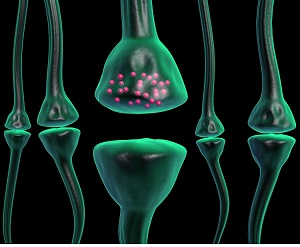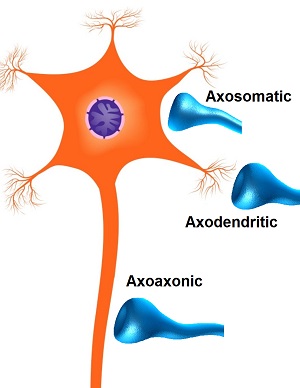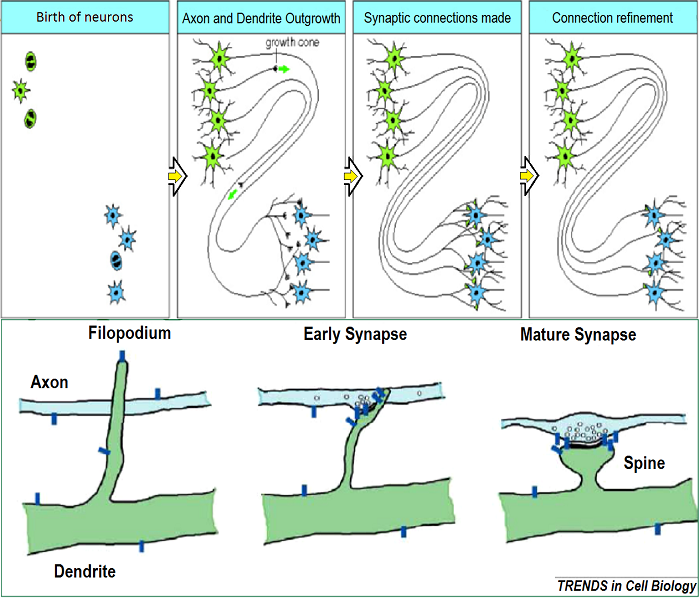02 Jan Synapse Formation
Many neurons have only a few synapses. Others, like giant pyramidal and Purkinje cells, may have tens or even hundreds of thousands of synapses. At the conclusion of the complex growth process, called synaptogenesis, in which growth cones at the tips of spines, axons, and dendrites propel or draw the fiber through the crowded gray and white matter of the brain to make exactly the right connections, synapses form. There are several complex chemical and genetic interactions, as well as environmental factors, that determine nerve-fiber growth and synapse formation.
 Neurites are guided to their targets through growth-cone probing that involves chemicals known as neurotransmitters. Remember, neurites grow directionally in imposed electrical fields (described in the preceding post). Both the chemical and electrical mediation of nerve-fiber growth indicate the possibility that electrochemical impulses generated in sensory or cognitive processing may determine where synapses are formed (see Kater & Letourneau, 1985).
Neurites are guided to their targets through growth-cone probing that involves chemicals known as neurotransmitters. Remember, neurites grow directionally in imposed electrical fields (described in the preceding post). Both the chemical and electrical mediation of nerve-fiber growth indicate the possibility that electrochemical impulses generated in sensory or cognitive processing may determine where synapses are formed (see Kater & Letourneau, 1985).
Growth Processes
- Chemotaxis = Chemical guidance
- Haptotaxis = Adhesive support
- Galvanotaxis = Electric guidance
| Understanding Context Cross-Reference |
|---|
| Click on these Links to other posts and glossary/bibliography references |
|
|
|
| Prior Post | Next Post |
| Axon and Dendrite Growth | Synapses and Neurotransmitters |
| Definitions | References |
| neurons synapses | Kater & Letourneau 1985 |
| neurite E/I | Yishi Jin on Synaptogenesis |
| dendrite axon | Takizawa 2012 |
For a brief overview of synaptogenesis that describes the process very well, open this link to Yishi Jin’s page on synaptogenesis.
- Neurons are initially produced along the central canal in the neural tube
- These neurons then migrate from their birthplace to a final destination in the brain
- They aggregate to form each of the various brain structures and acquire specific ways of transmitting nerve messages
- Their axons grow long distances to find and connect with appropriate partners, forming elaborate and specific circuits
- When an axon tip gets to an appropriately marked destination cell, the contact starts a process that develops synapses
- Local competition among neural axons with similar marker profiles produces some further tuning at the destination
- Finally, sculpting action eliminates redundant or improper connections, honing the specificity of the circuits that remain
- The result is the creation of a precisely elaborated adult network of 100 billion neurons capable of a body movement, perception, emotion and thought
Although there may be an element of randomness in the specific loci of cell-to-cell connections, the locality and functionality of each synapse in the brain are not determined by chance, but by preprogrammed and environmental factors which mediate the navigation of the growth cone as described in the prior post.
 Synapse Types
Synapse Types
Impulses are transmitted over synapses. As impulses are transmitted from axons, their destination distinguishes the type. The three main types of synaptic gaps are named for their origin and destination:
- Axodendritic: formed when an axon terminates on a dendrite.
- Axosomatic: formed when an axon terminates on the cell body.
- Axoaxonic: formed when an axon terminates on another axon.
There are also variations on these three main types.
The proximity of the synapse to the cell body or to the axon may impact how the cell responds to the aggregate input of incoming signals. An inhibitory pulse closer to the soma or axon than one or more excitatory pulses could have more canceling impact than either type of pulse more distant from the center. Such inhibitory synapses may grow to block or “unlearn” incorrect information.
Axons transmit outgoing signals, thus the designation “pre-synaptic” describes their primary role in propagating excitation and inhibition along the pathways of thought. Axons produce and distribute E/I. Dendrites reach out and grab input thus they are “post-synaptic” receivers to accept impulses and send them into the cell where, aggregated with all input from all distributors, the signal will continue on or stop there. This distributed model of responsibility, leaving much to each neuron in the system, creates mechanisms that can grow, learn and self-heal. While computers will likely never have the billions of neurons and tens of billions of links like the human brain, the model is worth understanding to design better, more intelligent automata for assuming brain tasks such as language understanding and problem solving.
| Click below to look in each Understanding Context section |
|---|










